Coat of arms of Græcia
| Coat of arms of Græcia | |
|---|---|
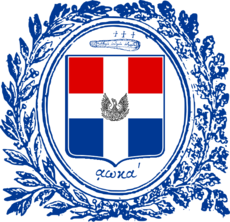 | |
| Versions | |
 Lesser coat of arms | |
| Details | |
| Armiger | Governorate of Græcia |
| Adopted | 12 October 2020 AD |
| Crest | Rigas Feraios' club of Heracles, with the words "Liberty — Equality — Fraternity" in Hellenic superimposed on it, and three crosses topping it. |
| Escutcheon | Gules (top-half) and Azure (bottom-half), a Hellenic Cross throughout Argent; charged with a black Hellenic phoenix in the centre. |
| Supporters | Three ovals and two laurel branches |
| Motto | The date "1821" (the year the Hellenic War of Independence began) in Hellenic numerals (ᾳωκα΄). |
| Earlier versions | See previous designs |
| Use | Governmental |
The coat of arms of Græcia (Hellenic: Μικροεθνόσημον τῆς Γραικίας Mikroeþnósīmon tī̃s Ğrēkías, Neoclassical Latin: ĪNSĪGNE GRÆCIÆ, South Ruthenian: Знакъ Грѣкійъі Znakě Hrækijî), is one of the national symbols of Græcia.
History
The current coat of arms was adopted alongside the first constitution of Græcia, on the 12 October 2020 AD, the day the microstate was officially established.
Design
The coat of arms of Græcia, as described in the decree:
The Græcian coat of arms is a shield, with in its central portion a white symmetrical cross touching all four sides of the shield. The top two corners are red and the bottom are blue. A black phoenix is superimposed on the center of the cross. A blue club of Heracles, with the words "Liberty — Equality — Fraternity" superimposed on it and three crosses topping it, is above of the shield. The year "1821" written in Hellenic numerals (ᾳωκα΄) is below the shield. They are surrounded by three blue ovals and two blue branches of laurel.
| Scheme | Red | White | Blue | Black |
|---|---|---|---|---|
| RGB | 221-0-0 | 255-255-255 | 0-56-147 | 0-0-0 |
| CMYK | 0-100-100-13 | 0-0-0-0 | 100-62-0-42 | 0-0-0-100 |
| Pantone | 2347 C | Safe | 661 C | Black |
| Web | #dd0000 | #FFFFFF | #003893 | #000000 |
As with the national flag, the design was inspired by one of the flags used by the island of Samos between 1834 and 1912 AD, when Samos was an autonomous tributary Principality of the Ottoman Empire, which was virtually the same flag, without the phoenix, which was added by the Græcian government. The coat of arms combines elements of the current and previous coat of arms of Hellas: the shield (current coat of arms), the phoenix (from the 1973–1974 government gazette header), the ovals and the laurel branches (from the First Hellenic Republic's government gazette header), «ᾳωκα΄» (from the 1828–1832 seal of the First Hellenic Republic), and the club of Heracles, proposed by Rigas Feraios in 1797 AD.
Previous coats of arms
Provisional Government of Græcia (20/08–12/10/2020)
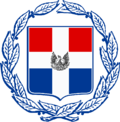
The first Græcian coat of arms was adopted by the Provisional Government of Græcia as soon as the microstate's foundations were laid. It featured the same shield as the lesser coat of arms, but the laurel branches surrounding it were matching the ones of the current Hellenic coat of arms.
A lot of designs were considered by the state-appointed graphic artists for the first coat of arms of Græcia, but they ultimately decided to copy the one used by the Third Hellenic Republic.
It was comprised of the following elements: a white Hellenic Cross on a red and blue escutcheon with a black phoenix superimposed on the center of the cross, surrounded by two laurel branches.
On 12 October 2020, the day the micronation transitioned from the Provisional Government to being a Governorate, the new government immediately replaced it with its own coat of arms, effectively incorporating the same shield, albeit with a much more complex surrounding design. It was unanimously approved by the Senate and by the same evening, it had replaced the previous one in all official documents, posters, etc.
Subdivision coats of arms
Voivodeships
| Coat of arms | Adopted | Voivodeship | Blazon | Other elements |
|---|---|---|---|---|
 |
1 March 2021 AD | Aegean Voivodeship (Βοεβοδάτον τοῦ Αἰγαίου) |
Azure a Bordure, Argent, a Hellenic Cross in the canton, Argent, a Byzantine double-headed eagle with its wings displayed and abaissé, Argent, clutching a sword, Argent, and an orb, Argent, with a crown, Argent, above and between its two heads. |
The inscription "ΗΕΑ ΗΘΣ" (Freedom or Death, the motto of Hellas), Argent. |
| 10 June 2022 AD | Atthicon Voivodeship (Ἀτθικόν Βοεβοδάτον) |
Gules (top-half) and Azure (bottom-half) a Bordure, Tenné, a Hellenic Cross throughout Or a Bordure, Tenné; charged with a black Hellenic phoenix in the centre. |
The inscription "ΑΤΘ" (short for "Atthicon"), Tenné. | |
 |
1 March 2021 AD | Voivodeship of Magna Græcia (Voivodato di Magna Grecia) |
Party per fess a Bordure, Sable, eight equally-sized vertical stripes, Or and Gules; the base Azure, a trident-head in the center, Argent. |
The inscription "ΜΕΓΑ ΤΟ ΤΗΣ ΘΑΛΑΣΣΗΣ ΚΡΑΤΟΣ" ("Be glorious State who rule the Sea", the motto of the Hellenic Navy), Argent. |
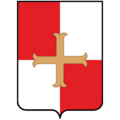 |
1 March 2021 AD | Moreas Voivodeship (Βοεβοδάτον τοῦ Μωρέως) |
Party per cross with bordure, Sable, quarterly Gules and Argent, a cross moline Or. | — |
 |
1 March 2021 AD | New Yugoslavia Voivodeship (Војводство Нова Југославија) |
An eagle displayed with two heads Argent armed Or, between two fleurs-de-lys in base Or, surmounted by an inescutcheon with a bordure, Or, party per cross, quarterly I Azure, an Istrian goat chief sinister, Or, a Slavonian ferret chief dexter, Brunâtre, a Croatian interlace centered, Argent, the three Dalmatian crowned lion heads affrontés caboshed, Or, the Illyrian six-pointed star, Or, over a crescent moon, Argent; II Azure, a fleur-de-lys centered, Or; III Gules, the Montenegrin lion passant centered, Or; IV Gules, a cross between four firesteels, Argent, thereon a cross, Argent |
A horizontal triband of blue, white and red above the escutcheon. |
As of 10 June 2022 AD, the micronation of Græcia is divided into five voivodeships, each of which bears its own flag:
- The design for the coat of arms of the Aegean Voivodeship is an original concept, featuring the elements of the flag of the voivodeship.
- The design for the coat of arms of the Atthicon Voivodeship was derived from the coat of arms of the Kingdom of the Morea (1688–1715), a colony of the Republic of Venice. Apart from slight colour changes, the major differences are the addition of the black phoenix, as presented on the national coat of arms of Græcia, and a three-letter inscription below it, which serves as the Hellenic abbreviation of the name "Atthicon" (Hellenic: Ἀτθικόν).
- The design for the coat of arms of the Voivodeship of Magna Græcia is an original concept, featuring the flag of the voivodeship, as well as a navy blue base with a trident-head and a Hellenic naval motto. It is speculated that the design was derived from the traditional home kit of U.S. Lecce, an association football club based in Lecce, Apulia, the macronation of Italy.
- The design for the coat of arms of Moreas Voivodeship is the fusion of the two coats of arms of the Principality of Achaea (aka Principality of Morea), which was one of the three vassal states of the Latin Empire, between 1204 and 1432 AD; the red and white quarters from the coat of arms of the Zaccaria family (last ruling dynasty) and the cross from the coat of arms of Villehardouin family (first ruling dynasty).
- The design for the coat of arms of the New Yugoslavia Voivodeship was derived from the Serbian eagle featured in the coat of arms of the Republic of Serbian Krajina, as well as the former coat of arms of Republika Srpska (used between 1992 and 2007 AD). Above the shield, a horizontal triband of blue, white and red is featured, as a Yugoslav notion. Each of the shield's quarters features heraldic elements of the four former Yugoslav states that speak their respective standard form of Serbo-Croatian: Croatia (top-left), Bosnia and Herzegovina (top-right), Montenegro (bottom-left) and Serbia (bottom-right), all separated by the white cross. Although it looks like the inverted flag of Græcia, the colours actually once again symbolise Yugoslavia (blue-white-red).
Boroughs
| Coat of arms | Adopted | Borough | Crest | Blazon and other elements | Supporters | Motto |
|---|---|---|---|---|---|---|
 |
13 October 2020 AD | Andriopolis (Ἀνδριόπολις) | n/a | Barry of ten Azure and Gules with a bordure Sable, a carrack Argent, the inscription "ᾳωκα΄", Argent. |
n/a | — |
 |
13 October 2020 AD | Čěrneś (Чърнєсь) | n/a | Argent with a bordure Or, a double-headed eagle Sable, a triband Azure, Argent, Gules, and a kolovrat Sable, the inscription "ЧЪРНЄСЬ", Azure. |
n/a | — |
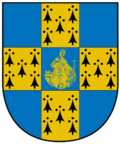 |
13 October 2020 AD | Hagia Aikaterini (Ἁγία Αἰκατερίνη) | n/a | Chequy Azure and Erminois with a bordure Sable, Saint Catherine Or. | n/a | — |
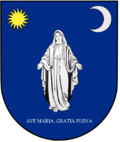 |
12 November 2020 AD | Marijin breg Assumption of the Blessed Virgin Mary (Uznesenje Blažene Djevice Marije) |
n/a | Azure with a bordure Sable, Virgin Mary with open hands Argent, the Sun Or, the Crescent moon Argent, the inscription "AVE MARIA, GRATIA PLENA", Argent. |
n/a | — |
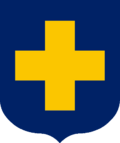 |
10 June 2022 AD | Nea Ionia (Νέα Ἰωνία) | n/a | Azure, a Hellenic Cross couped Or | n/a | — |
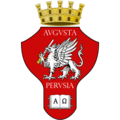 |
1 March 2021 AD | Perusia (PERVSIA) | A mural crown of an Italian city, Or |
Horsehead shield Gules, a griffin passant Argent, a sword Argent, Or, the inscrptions "AVGVSTA" and "PERVSIA" above and below the griffin respectively, Argent, a book, Argent, featuring the Hellenic letters Alpha and Omega, Sable. |
n/a | — |
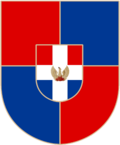 |
10 June 2022 AD | Pŕvotræv'njskě (Прьвотрѣвьньскъ) | n/a | Quarterly: 1; Gules, a Bordure, Or, 2; Azure, a Bordure, Or, 3; Gules, a Bordure, Or, 4; Azure, a Bordure, Or. On an Inescutcheon a Bordure, Or, en surtout, Gules (top-half) and Azure (bottom-half), a cross throughout Argent; charged with a Hellenic phoenix in the centre. |
n/a | — |
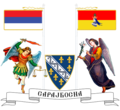 |
1 March 2021 AD | Sarajbosna (Сарајбосна) | n/a | Azure, with six Lilies, Or, displayed around a bend, Argent, all within a bordure, Or. |
Taxiarches Archangels Michael holding a fiery sword and a scale (left) and Gabriel holding a lily (right), behind the flag of Republika Srpska and a fictional Bosnian flag, featuring the Austro-Hungarian colours of the Bosnian flag, as well as the coat of arms of the Kingdom of Bosnia, respectively. |
САРАЈБОСНА, Sable |
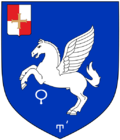 |
1 March 2021 AD | Sisypheia (Σισυφεία) | n/a | Azure, a pegasus Argent, the Hellenic numeral equivalent to 900, Argent, the Hellenic letter Koppa, Argent, and inescutcheon in chief sinister, the coat of arms of the Moreas Voivodeship |
n/a | — |
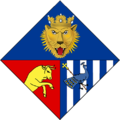 |
1 March 2021 AD | Vathy (Βαθύ) | n/a | Party per fess, Azure, a crowned lion's head, Or; the base per pale, Gules sinister, a bull salient, Or; paly Azure and Argent dexter, a peacock close Azure, behind a stick, Tenné, with a Christian Cross, Or. |
n/a | — |
As of 10 June 2022 AD, the micronation of Græcia is divided into ten boroughs, each of which bears its own flag:
- The design for the coat of arms of Andriopolis was inspired by the coat of arms of Lusignan-Petit, a commune in the macronation of France; the white bands were coloured as the blue parts and the blue bands were coloured as the red parts of the Græcian coat of arms .
The sailing ship symbolises the naval tradition of the island of Andros. Below the sailing ship is written the year "1821" in Hellenic numerals, to honour the year the Hellenic Revolution against the Ottoman Empire began. - The design for the coat of arms of Čěrneś is an original concept; a white shield featuring a Byzantine eagle, symbol of the Græco-Roman civilisation, a kolovrat, an Old Slavic symbol of the spinning wheel, the continuous circle of life and death, as well as a triband featuring the Panslavic colours (blue, red, and white), in the same order as they were featured on the flag of FR Yugoslavia, as well as the name of the borough, written in South Ruthenian, the constructed language spoken by the locals. According to the constitution, the white colour of the shield symbolises peace and purity, the prominent black colour of the two symbols is a symbol of sorrow. The whole concept is a reminder that the Sclaveni, the early Slavic tribes that raided, invaded and settled the Balkans in the Early Middle Ages, the forefathers of today's South Slavs, shall not become a forgotten part of Hellenic history.
- The design for the coat of arms of Hagia Aikaterini was derived from the coat of arms of the Duchy of Athens during the rule of the De la Roche family (13th century); the red squares were coloured the same shade of blue with the borough's flag , whereas the squares containing the ermines were coloured yellow . The only detail that makes this coat of arms truly different is the yellow-tinctured outline of the figure of Saint Catherine, after whom the borough was named.
- The design for the coat of arms of Marijin breg was inspired by the coat of arms of Zagreb, the capital city of the macronation of Croatia, since the borough is located there. The only common elements are the blue shield and the white crescent; in stead of a yellow star, there is a yellow sun, broadly resembling the symbol of the Székelys, the Hungarian minority of the macronation of Romania. Below them, stands the figure of the Blessed Virgin Mary with her arms open, derived from the coat of arms of Saturargues, a commune in the macronation of France.
There is a Latin phrase below Mary, a prayer from Saint Luke's Gospel: "Hail, full of grace [...]" (Ave Maria, gratia plena [...]). - The design for the coat of arms of Nea Ionia was derived from the one used during the Second Hellenic Republic (1924–1935); it's the same design, albeit incorporating the colours of the flag of the borough: dark blue and gold .
- The design for the coat of arms of Perusia is an original concept, featuring the same beast as the flag of the borough, a typical Italian city's mural crown, the honorific name of the city in Latin ("AVGVSTA PERVSIA"), as well as a Christian symbol; a book with the Hellenic letters Alpha and Omega, an appellation of Jesus Christ and God in the Book of Revelation.
- The design for the coat of arms of Pŕvotræv'njskě is an original concept, featuring a quarterly shield and an inescutcheon with the central portion of the Græcian flag, albeit with the phoenix depicted as the one on the flag of the borough.
- The design for the coat of arms of Sarajbosna was inspired by the coat of arms of East Sarajevo (formerly Serbian Sarajevo, between 1992 and 2004); the tricolour flag of the Serbs, as well as the Archangels Michael and Gabriel and the ribbon were redesigned for the purposes of Sarajbosna's coat of arms; apart from that, the coat of arms features the House of Kotromanić shield, which is also depicted on the borough's flag, as well as a fictional flag, which combines the red and yellow colours of the flag of Bosnia and Herzegovina under Habsburg rule, with the coat of arms of the Medieval Kingdom of Bosnia, which was ruled by Kotromanić family.
- The design for the coat of arms of Sisypheia is an original concept, inspired by an ancient Corinthian tridrachm, from the 4th c. BC, which also features Pegasus and the initial letter of Corinth in Ancient Hellenic. Since the city of Corinth was founded on 900 BC, the coat of arms also features the Hellenic letter sampi, which in Hellenic numerals is the equivalent of 900. Last, but not least, the coat of arms also features the coat of arms of Moreas Voivodeship as an inescutcheon.
- The design for the coat of arms of Vathy was derived from the lesser coat of arms of the Principality of Samos; the solid blue and red fields symbolise the history of the principality, while the blue-and-white striped field symbolises the undisputed Hellenic rule over the island of Samos.
Free Cities
Free City of Phlyeia
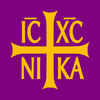
The coat of arms of the Free City of Phlyeia, much like the city's flag, was inspired by Byzantine (Eastern Roman) flags. More specifically, it bears an amber Christogram (Ⲓ҃Ⲥ Ⲭ҃Ⲥ ⲚⲒⲔⲀ), Ἰησοῦς Χριστὸς νικᾷ "Jesus Christ Conquers") on a purple (aubergine) square field. This particular design was chosen, in order to emphasize the origins of the city, which was established in AD 2014 as the kingdom (and later exarchate under Imvrassia) of Great Ionia.
Scheme
| Scheme | Aubergine | Amber |
|---|---|---|
| RGB | 128-0-128 | 255-191-0 |
| CMYK | 0-100-0-50 | 0-25-100-0 |
| Pantone | Fresh Eggplant | Amber |
| Web | #800080 | #ffbf00 |
Description
A square purpure, a Christogram cross Or thereon.
Free City of Porto Leone
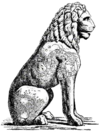
The coat of arms of the Free City of Porto Leone is the black outline of the Piraeus Lion, a statue of a lion looted by the Venetian doge Francesco Morosini in AD 1687. The statue is now on display at the Venetian Arsenal. The statue was chosen as it is a symbol of Piraeus, the macronational city surrounding Porto Leone.
Description
Piraeus Lion sejant sinister Sable